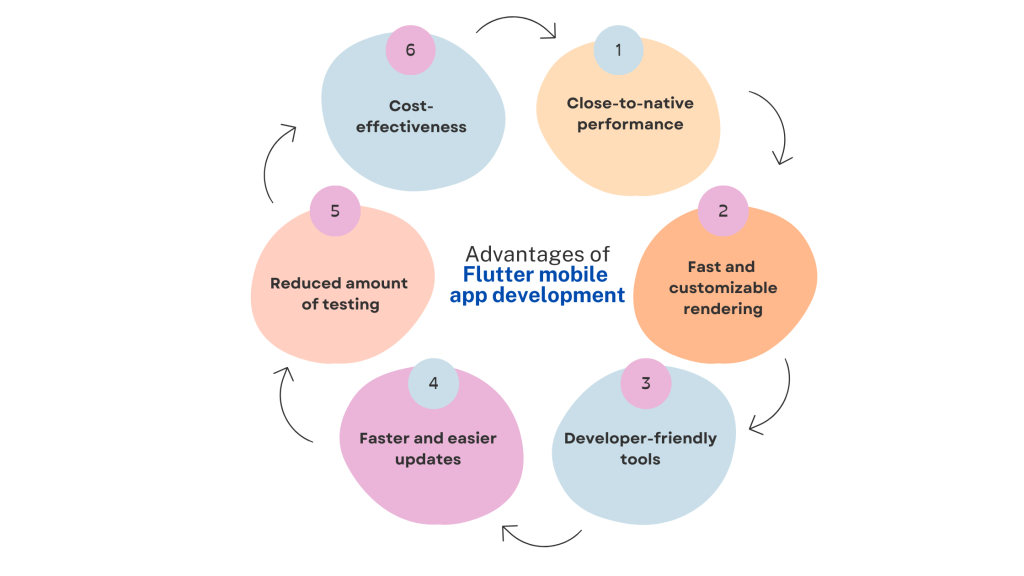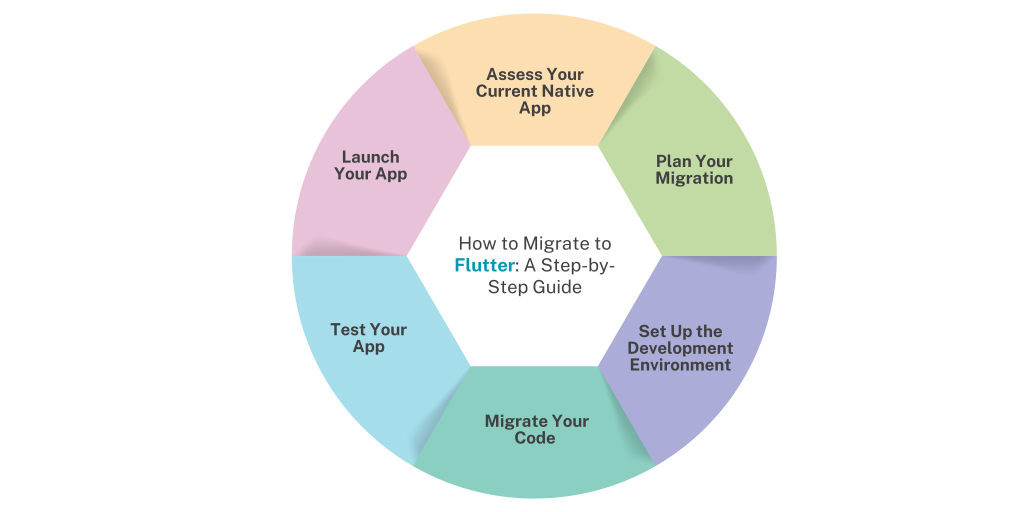Do you feel like juggling between separate codebases for your iOS and Android app? You are not alone! Businesses often face challenges over inconsistent UIs and push app updates when dealing with native mobile apps. Luckily, you can now end all these dilemmas with Flutter mobile app development.
That’s right! Migrate your existing app to Flutter and bid farewell to costly updates, complex UIs, and separate codebases. Read on to learn more about migrating native apps to Flutter.
What is Flutter?
Launched in 2018, Google’s Flutter is an open-source software development kit that helps you develop mobile apps faster and easier. It allows you to build high-quality apps for Android and iOS using a unified codebase. In addition to Android and iOS app development, Flutter also supports application development on other platforms like the web, Windows, MacOS, and Linux.
With 46% of software developers using Flutter, it is the most popular cross-platform mobile framework worldwide. Some of the top companies relying on Flutter mobile app development include:
• Alibaba
• Baidu
• Google Pay
• iRobot
• Kotak
• Philips Hue
• Realtor.com
Why Choose Flutter for Migrating Native Apps?
Since Flutter is a cross-platform development framework, it allows you to build an application for multiple platforms with a single codebase. This simplifies the process of developing consistent, appealing UIs for a mobile app. The best part? Flutter apps run fast, look great, and are functional on all major app platforms.
The advantages of Flutter mobile app development:

• Close-to-native performance:
By using the powerful programming language Dart, Flutter compiles into machine code. It allows apps to host several devices and ensures a fast and effective performance.
• Fast and customizable rendering:
Rather than using platform-specific rendering tools, Flutter relies on Google’s open-source Skia graphic library. This makes rendering UI smoother and faster, providing users with consistent visuals no matter the platform.
• Developer-friendly tools:
Since Google developed Flutter, the framework is easy to use. It supports tools like hot reload to help developers preview what code changes will look like without losing state.
• Faster and easier updates:
Due to a single codebase, making updates and fixing bugs become a lot simpler. Developers no longer have to write separate patches for different app platforms, speeding up the update process.
• Reduced amount of testing:
Flutter’s single codebase approach also means less code and fewer tests. This speeds up the development process while reducing the chances of bugs slipping through.
• Cost-effectiveness:
By reducing the development time and resources, you can cut down the cost of app development. This makes it an attractive migration option for businesses on a tight budget.
When to Switch Your Native Apps to Flutter?
Migration to Flutter is not a one-size-fits-all approach. Though it has much more to offer, some apps are better suited for the transition than others. So which apps are best for the migration? Let’s find out!
Medium-complexity apps: Mobile apps with complex UIs, complex animations, or moderate features fit best in the Flutter ecosystem.
Scale-up apps: Applications that perceive their deployment beyond mobile, such as on desktop or web-based platforms, would do well with Flutter.
Heavily maintenance intensive: Apps that need periodic updating or bug fixing prefer Flutter’s single development platform.
App modernization: An outdated UX/UI design can result in high churn rates, but Flutter is an expressive and flexible UI framework that allows for modern designs.
How to Migrate to Flutter: A Step-by-Step Guide

If your app relies on features specific to native platforms, it can be a bit tough to migrate. Still, it is possible with Flutter application development services. Keep in mind that migrating isn’t an overnight process; it requires careful planning to avoid disruptions. Here’s how to approach it:
Step 1: Assess Your Current Native App
First thing first, conduct a thorough evaluation of your existing app to understand the intricacies of its architecture, the features it offers, and its performance metrics. This will help you identify the key areas that can benefit from Flutter mobile app development.
What to look out for:
• Native features: Does your app use AR, NFC, or other native features?
• Age of codebase: The older your app is, the greater its need for refactoring.
• User interface: How complicated is your existing UI design and how closely can it be improved with Flutter?
Step 2: Plan Your Migration
Once you evaluate your current app, the next step is to create a detailed migration plan. It encompasses a realistic timeline and resource allocation to tackle potential challenges that might crop up during the migration. Keep in mind that there are two different types of migrations:
• Gradual Migration: It includes gradually migrating features to Flutter while keeping the most significant features in native.
• Total Refactoring: It includes reworking the entire app with Flutter. This approach is best for old apps or severely battered apps.
Step 3: Set Up the Development Environment
Before migrating your native apps, set up your development environment, such as installing Flutter and Dart on your system. If you are new to Flutter, get yourself familiar with the framework’s nuances. Otherwise, it’s better to rely on Flutter application development services for a smooth migration.
Once done, use the widgets library of Flutter to create an exact clone of your app’s UI. It will be an improved version of UI. Also, pay attention to a responsive layout that works great across devices.
Step 4: Migrate Your Code
Migrating your code to Flutter is a critical part as it requires you to test and validate each part of your app as you progress. This iterative approach helps you ensure that any bugs or issues are addressed promptly.
Plus, some native features like access to GPS, the camera, or SDKs will have to be driven deeper. This is where Flutter’s platform channels enable smoothly migrating native code from Swift, Kotlin, and other native app frameworks.
Step 5: Test Your App
So, the migration is done finally! Now what? It’s time to test your Flutter app on multiple devices and platforms to ensure it performs as expected and offers a seamless user experience.
Flutter provides both unit tests, widget tests, and integration tests to help catch bugs at an early stage. So, test on all the emulators and physical devices to confirm performance in different hardware.
Step 6: Launch Your App
Once you’re satisfied with your app’s performance, functionality, and speed, you can successfully launch it on the App Store and Google Play Store. Just remember, post-launch support is crucial to address any user feedback.
Thus, make necessary improvements when required. Start with a beta release. Break all the usability and performance issues before the complete roll-out.
Potential Challenges With Migration and How to Overcome Them
While Flutter mobile app development ensures a smooth migration for native apps, the process may come with some challenges. The process can be complex and requires careful planning and execution. However, the benefits of a successful migration can outweigh these challenges. Here are some of the common challenges and how to tackle them:
• Learning Curve
Whether you are migrating from Swift/Objective-C for iOS or Kotlin/Java for Android to Flutter, understanding and using the programming language Dart will take time. The key is to invest in hands-on training and pair junior developers with experienced Flutter engineers. Or, seek help from an experienced Flutter app development agency to save on your resources and time.
• Compatibility and Third-Party Integrations
When migrating native apps to Flutter, ensuring compatibility with the existing code and third-party integrations can be challenging, especially if the existing app was developed using a different programming language or framework.
This is where Flutter’s library comes equipped with different widgets and libraries for creating custom UI and integrating with third-party APIs. If compatibility issues keep on arising, they can be resolved with Flutter application development services.
Also, native features sometimes require additional effort to replicate in Flutter. Luckily, you can use plugins from Flutter’s ecosystem or create custom integrations using platform channels.
• Maintaining the Look of the Existing App
Another key challenge when migrating to Flutter is to maintain the look and feel of the existing native app. This makes more sense because users are accustomed to the existing user interface. Thus, any significant changes might disrupt the user experience.
The best solution is to create custom widgets in Flutter. Make sure they mimic the look and feel of the existing native app. This will help you replicate the look, so that the app performs exactly or even better than the original app.
• Keeping Up with Updates and Changes
Frequent updates and changes are another challenge with migration as platforms like Android and iOS are constantly evolving. Thus, your app needs to be updated regularly to stay compatible with the latest changes.
Luckily, the Flutter framework is designed to be future-proof. It focuses on maintaining backward compatibility and staying up-to-date with the latest platform changes. On top of that, the framework also provides a hot-reload feature to enable testing and iterate changes.
• Larger App Size
Please note that Flutter apps are a bit bulkier than native apps. This is mainly because of the framework’s bundled engine, Dart runtime, and assets. This additional overhead can be a concern, especially for applications targeting regions where users have limited storage capacity or slower internet connections for downloads.
As a result, UI/UX can result in poor engagement and high churn rates. Here, the best approach is to optimize assets, remove unused libraries, and use code splitting techniques. Also, enable ProGuard and rely on Dynamic Delivery for Android.
• Minimizing Disruption to the Existing User Base
It’s true that migration can potentially disrupt the existing user base, especially when the migration is not done properly. This may lead to a loss of users, negatively impacting your app’s success.
Make sure the migration to Flutter is done seamlessly, with minimal disruption to the existing user base. Hire an app development agency to ensure improved performance and functionality, so the app can attract new users and retain existing ones.
Summing Up
Businesses are constantly looking for different ways to streamline their app development processes, reduce costs, and ensure their apps hold up well in the $260 billion app development market. This is what makes Flutter mobile app development a boon for building natively compiled cross-platform applications. So, if you are thinking of migrating your native app to Flutter, this is the right time to get started with the help of a leading app development agency.
FAQs:
Is it possible to rewrite a mobile app using Flutter?
Yes, if your native mobile application has an adequate architecture. However, some native codes may remain in the project. So be sure to solve issues related to the in-app navigation.
When should I migrate native mobile apps to Flutter?
Whether you need multi-platform support, have high maintenance costs for separate codebases, want to speed to market, or are planning to scale the app, it’s always a great option to migrate your apps to Flutter.
What makes Flutter better than other cross-platform tools?
While each cross-platform framework has its own pros and cons, Flutter is much more stable and faster than other cross-platform frameworks, such as React Native, Xamarin, and Ionic. It is an efficient tool for developing simple apps and prototyping in almost all cases.
Why should I choose SoftProdigy for Flutter migration?
At SoftProdigy, we have extensive experience in mobile app development and migration. Our team of certified Flutter developers specializes in seamless app transitions, ensuring high performance, intuitive designs, and robust cross-platform compatibility. We focus on reducing time-to-market, optimizing app size, and preserving your app’s original functionality. Request a free quote today for your migration project!











